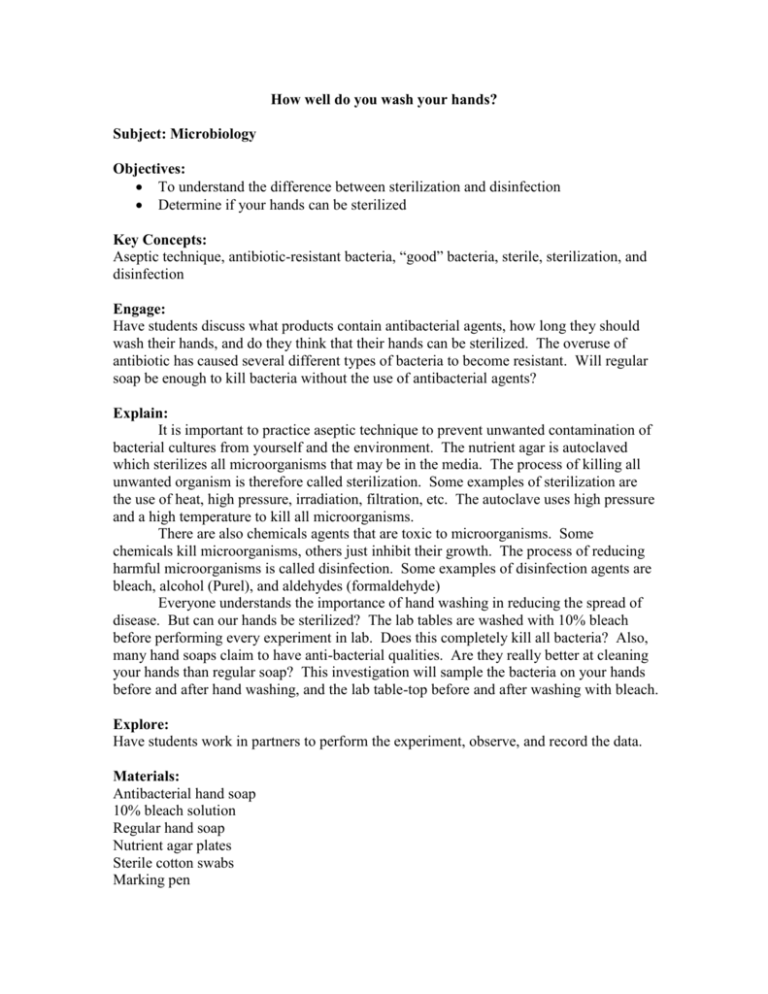How well do you wash your hands
advertisement

How well do you wash your hands? Subject: Microbiology Objectives: To understand the difference between sterilization and disinfection Determine if your hands can be sterilized Key Concepts: Aseptic technique, antibiotic-resistant bacteria, “good” bacteria, sterile, sterilization, and disinfection Engage: Have students discuss what products contain antibacterial agents, how long they should wash their hands, and do they think that their hands can be sterilized. The overuse of antibiotic has caused several different types of bacteria to become resistant. Will regular soap be enough to kill bacteria without the use of antibacterial agents? Explain: It is important to practice aseptic technique to prevent unwanted contamination of bacterial cultures from yourself and the environment. The nutrient agar is autoclaved which sterilizes all microorganisms that may be in the media. The process of killing all unwanted organism is therefore called sterilization. Some examples of sterilization are the use of heat, high pressure, irradiation, filtration, etc. The autoclave uses high pressure and a high temperature to kill all microorganisms. There are also chemicals agents that are toxic to microorganisms. Some chemicals kill microorganisms, others just inhibit their growth. The process of reducing harmful microorganisms is called disinfection. Some examples of disinfection agents are bleach, alcohol (Purel), and aldehydes (formaldehyde) Everyone understands the importance of hand washing in reducing the spread of disease. But can our hands be sterilized? The lab tables are washed with 10% bleach before performing every experiment in lab. Does this completely kill all bacteria? Also, many hand soaps claim to have anti-bacterial qualities. Are they really better at cleaning your hands than regular soap? This investigation will sample the bacteria on your hands before and after hand washing, and the lab table-top before and after washing with bleach. Explore: Have students work in partners to perform the experiment, observe, and record the data. Materials: Antibacterial hand soap 10% bleach solution Regular hand soap Nutrient agar plates Sterile cotton swabs Marking pen Safety/Disposal: For today only, do not wash hands and bleach the tables before you begin. Dispose of materials in a manner indicated by your instructor. Wash your hands thoroughly before leaving the lab. Procedure: 1. Obtain 3 nutrient agar petri dishes and draw a line down the middle on the bottom side of the plate and label accordingly. 2. Both partners need a petri dish. Take a sterile cotton swab and rub it over every part of the hand, in-between the fingers and on the palm. Then use the same swab and rub the corresponding side of the petri dish labeled “Unwashed hand”. 3. One partner needs to wash hands with soap and the other partner needs to wash hands with soap without antibacterial agents. Then swab hands and rub it on the corresponding side of the plate. If necessary to prevent from touching anything after washing hands, each partner may have to help the other by turning the faucet on and off and lifting the petri lid. 4. On the third plate, swab the table top before it is bleached and then rub it on the side of the petri dish labeled “non-bleached table”. Then bleach with 10% bleach and let the table-top dry. Next swab the table-top again and then rub the swab on the side of the petri dish labeled “Bleached Table”. 5. Invert all dishes and incubate at room temperature for 48 hours. 6. After 48 hours, examine all of the dishes for microbial growth. 7. Record observations in the chart on the worksheet and complete the questions on the worksheet. Evaluate: Table Top Antibacterial Soap Before After 1. Write a paragraph about how this lab made you feel. Regular Soap No Soap 2. Are any of the “after” plates free of microbial growth? What does this tell you? 3. Which plates had more growth: the antibacterial soap or regular soap, were they equal? 4. What is the cause of the common cold? Can antibacterial agents kill the cause of the common cold? 5. Does bleach seem to be a good disinfectant? 6. Will this lab change the way you wash your hands or how often you wash your hands? Elaborate: Rub Glo Germ lotion on the student’s hands and see if they have improved their hand washing technique. Have students observe the different areas of the hand and see which areas still contain the glo germ lotion. Resource: Van Hoeck, K. Microbiology-Laboratories Activities. York High School, Elmhurst, IL 2002 Flinn Scientific, Inc.






